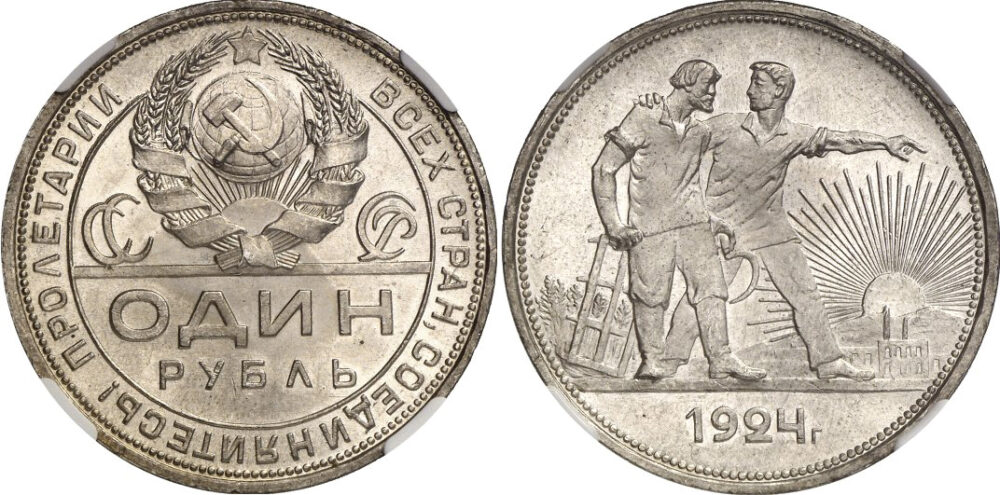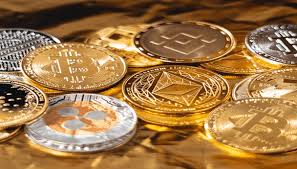The total cost of each of them exceeds five million rubles. These coins are listed in chronological order, as they were issued. The final prices are indicated in rubles and dollars at the exchange rate of that time.
The review included only those coins from private collections that were at public auction. Surely there are other rare coins that could complement our TOP of the most valuable coins of the USSR, but they were either sold behind the scenes, without advertising the final price, or simply did not change their owners yet.
It is solely for this reason that the “Zionist” ruble of 1977 did not get into the “golden ten” of the most expensive coins of the Soviet Union. Perhaps this is the most famous of the rare coins of the USSR, with which many numismatic legends are associated. It’s just that no one has ever put this coin up for auction, all its transitions were carried out from hand to hand.
Chevrolets 1923 as a Proof – 6,800,000 rubles.
A number of the most expensive coins of the USSR are opened by one of the first Soviet coins – the gold ducat “Sower” of 1923 in a polished design.
Numismatists have long known about its existence, but only according to documents, no one saw the coin “live”. And only in 2012 they were able to get acquainted with it in reality, since then several such copies have been sold at the largest auctions.
It is known that Chevrolets with a polished mirror field were minted at the Leningrad Mint in the late twenties. These improved quality coins were made especially for collectors and were sold at prices well above their face value. As a result, most of the polished chevroned “emigrated” to foreign numismatists, and only recently began to return “to their historical homeland.”
Until now, they are known only in piece copies, and the auction prices for these coins reach two to three million rubles.
The record at the moment is the amount of 6.800.000 rubles ($115.000), which was paid for such a coin in a very high degree of safety with a bright mirror field at the auction of the Coins and Medals (Mime) company in 2017. In the usual version, this coin is also very rare and costs about 150 thousand rubles.
Trial Chevrolets of 1925 – 5,000,000 rubles.
In 1925, it was decided to change the design of gold Chevrolets, replacing the symbols of the RSFSR with the all-Union one. Trial coins with the new coat of arms and the abbreviation of the USSR were minted in copper and gold, each sample was made in the amount of only a few copies.
To date, only five such gold Chevrolets have been preserved, kept in the collections of the Historical Museum and the Gopnik Museum.
The only known copy of the trial gold piece of 1925, made in copper, is in a private collection. It is considered one of the rarest and most valuable coins of the Soviet Union, and its value, achieved at the Mime auction in 2008, is 5 million rubles, or $ 170,000 at the exchange rate of that time.
50 kopecks 1929 – 10,000,000 rubles.
In the very first months of industrialization, the Soviet government thought about replacing the silver used for minting coins with another metal. The most suitable for this was a copper-nickel alloy – cupronickel. In addition to saving silver needed for industry.
this reduced the cost of manufactured coins by almost five times. To do this, in 1929, several copies of 10 and 50 kopeck coins were developed and minted in the form of samples from cupronickel, which was first used for coinage.
The copper-nickel 50 kopecks of 1929 turned out to be somewhat larger than the silver fifty kopecks of 1921-1927.
The images on the front and back of these trial fifty kopecks illustrated the victorious march of socialism across the country. On one was an image of large factory buildings, on the other – a tractor driving along a village street as a symbol of the collectivization and industrialization of the country.
According to the archival data of the Saint-Petersburg Mint, it is known that only two copies of this coin were minted. In the archive itself, a stamping tool was preserved, which was used to make trial 10 and 50 kopecks in 1929, but there are no coins themselves. These coins are not in state museums either. The only known copy of the 1929 fifty is in a private collection.
For the first time, photographs of 50 kopecks in 1929 were published only in 1991. And in 2011, it was put up for auction at Sank AD, after which it became widely known mainly due to the fact that when it was sold, it reached a record high price ever paid for a coin of the USSR – 10 million rubles ($ 330,000) .
Trial 10 kopecks in 1929 – 6,000,000 rubles.
10 kopecks of 1929 with the new symbols remained trial ones; these cupronickel coins were not approved for mass minting. They had a larger size, and in their manufacture would require almost one and a half times more copper and nickel than the other options under consideration, which was very undesirable at that stressful time.
According to the reporting data of the SPMD, 5 copies of this coin were minted from nickel and 5 copies from copper-nickel alloy. The fate of most trial 10 kopecks in 1929, unfortunately, is not known. Their production was known only from archival documents of the Mint. A relatively informative drawing of a 1929 nickel hryvnia was first published by well-known researchers of Soviet coins only in 1966.
And only at the end of 2017, real photos of this unique coin appeared on one of the numismatic forums. And a year later (at the end of 2018), it was put up for sale through the Moscow Rare Coins Auction House. According to the results of the auction, the final price for a trial 10 kopecks in 1929 reached 6 million rubles (90 thousand dollars). For almost 90 years, it was considered, in essence, a “coin – a ghost.” But as practice shows, sometimes these “ghosts” become a reality.





